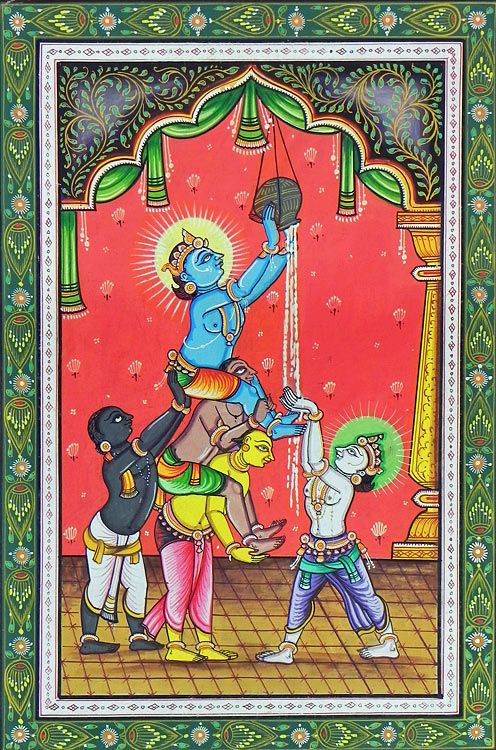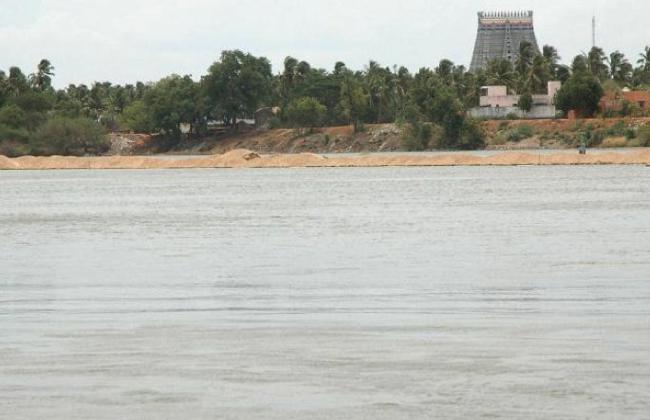A hallmark of Alvars pasurams is the high priority afforded to depiction of Nature and its beauty. These wandering minstrels, blessed with wonderful wisdom, go from place to place where the Lord has made His abode, much in the fashion of bees flirting from flower to flower in search of newer and newer varieties of honey. Just as the bees’ appetite for honey is boundless, Alvars’ proclivity for Bhagavad anubhava too is insatiable,as they sing His praises endlessly, remembering His innumerable exploits during His various avataras,ever grateful to Him for having afforded them the wisdom of choice between mundane pleasures and the everlasting one of divine bliss.
Nature occupies a pride place in Alvars’outpourings so much so that in a verse if two lines are devoted to the praise of the Lord of a particular DivyaDesa, the other two are reserved for a graphic description of the flora and fauna of the locale.
Alvars’ compulsion to describe the scenic beauty of the places they visit is so overwhelming that one wonders whether they were camera-toting tourists or saints after Bhagavad-anubhava. However, such doubts are easily resolved when we understand that beauty,wherever and whenever seen, reminds these seers of the bountiful creation of the Lord in all its kaleidoscopic colour and variety, and that while adulating Nature, they are in fact eulogizing the Lord as its Creator. The magnificent magic of a dewdrop sitting on the tip throwing out a diamond of a blade of grass and throwing out a diamond like dispensation of colours the indescribable beauty of single white crane standing on one leg with apparently infinite patience amidst a dazzling green fieldful of paddy crop waving its head ever so gently in the pleasant breeze, the rare music of a crystal-clear mountain stream wending its way from God-knows where, to some equally mysterious destination - all these strike Alvars as but facets of the innovative creation indulged in by the Lord and as aspects of His own divine form, in all its myriad manifestations.
It is hence no wonder that these peripatetic poets wax voluble while singing of whatever natural phenomena that confront them on their endless journeys from one divine abode to another. We thus have Sri Nammalvar adducing eloquent tribute to the scenic beauty off tirumalirumsolai-
“maruvil van sunai soozh rnalirumsohi”
(2- 10-5)
Tirumalirun Solai surrounded by pools of crystal clear water.“malamaru madi ser malirumsolai”
Tirumalirum Solai that confers blemishless wisdom.“mazba kalittrinam ser malirumsolai”
Tirumalirum Solai that is the resort of elegant elephants.“vayu mazbai tavazbum malirumsolai” etc.
(2- 10-4)
Tirumalirum Solai around which labouring clouds do play.
Sri Tondaradippodi Alvar furnishes a graphic description of the gorgeous groves surrounding Srirangam, the bewitching music of birds and bees, the majestic flow of the magnificent Cauvery whose waters are filled with gems and diamonds brought from far and wide, etc.
Endinam muralum sohi, mayilinam alum sohi,
Kondal meedu anavum sohi, kuyilinam koovum sohi
Gangaiyil punidamaya kaviri naduvu pattu
Pongu neer parandu payum poompozbil
arangam (Tirumahi- 14)
Srirangam is situated in the Solai, which is the haunt of murmuring bees, where peacocks dance, rain-bearing clouds
embrace, song-birds coo and which is encircled by the flowing waters of the Cauvery, holier than the Ganges.
From the ecstatic dance of Srirangam’s peacocks, to the magic-filled music of bees, all inspired by the bewitching beauty of Rangaraja, find gleeful mention in Sri Tiruppanazhwar‘s outpouring “vandu pada mamayilada”. Thus even during the brief span of his limited contribution of ten pasurams, this Alvar is unable to resist the temptation of touching upon nature and its beauty.
Even Sri Madhurakavi, who spurned singing the Lord and would eulogize only Sri Nammalvar, devotes a line to the natural beauty of Tirukkurugur, in his short but sweet “ Kanninun sirutthambu”- “kuyil nindru al pozhil soozh kurugur nambi!”
Sri Perialvar, Sri Andal, Sri Kulasekhara Perumal, and the three Mudal Alvars you name the Alvar and one could quote verse after verse depicting nature in all its magnificence.However, if one were to search for an Alvar who specialized in searching out scenic locales and singing their praises, one would have to crown Sri Tirumangai Mannan, for, his contribution, both in terms of number of pasurams and in terms of places covered, is the maximum. And in most places, the Alvar follows the invariable practice of devoting two lines of each verse to the flora and fauna of the Divyadesa and the other two to the Lord and His glory,obviously, considerin His Vibhuti as beautiful and praiseworthy as His own magnificent form and endearing exploits. One is able to imbibe a panoramic view of each Divyadesam, the type of trees inhabiting it, the sort of crops being sown in the water-filled fields, the incredible variety of wild life to be found in abundance, etc., the whole depiction presenting a picture of peace, prosperity and unspoilt environment. Abundant reenery aided by free-flowing rivers, wild ife flourishing amidst an atmosphere of safety and serenity, man living in absolute harmony with nature and benefiting therefrom in myriad varieties, Nature through unfailingly with bountiful rainfall which was copious but not excessive all these may be alien things to us in the present day and age, but were very much the order of the day during Sri Parakala’s times, as we come to know from his accounts of the numerous Divyadesams he visited.
However, amidst all these accounts of greenery and serenity, there is one which is outstanding for its total contrast from the normal run of fabulous foliage and fertility. At this particular Divyadesam, Sri Kalian encounters only barren rock radiating intolerable heat,scrubs and bushes that provide hardly any cover, predators waiting to pounce on the unsuspecting pilgrim and wild paths strewn with boulders and sharp stones.
One is able to imbibe a panoramic view of the DivyaDesa the type of trees inhabiting it the sort of crops being sown in the waterfields, the incredible variety of the wild life to be found in abundance, etc., the whole depiction presenting a picture of peace, prosperity, and unspoilt environment
Is it any wonder then that this Divyadesa was described by Sri Tirumangai Mannan as “chendru kandarkku ariya koil”
and “Daivam allal chella onna singavel kundram”, etc.? If Sri Parakala, who must be the hardiest of all the Alvars,
having braved the snow-filled and inhospitable climes of Badarikashrama, Salagrama etc., considers this particular Divyadesa as inaccessible to ordinary mortals, we can well imagine its harsh and hostile terrain and uninviting ambience. And which exactly is the Divyadesa the Lord has blessed with such dubious distinction of inaccessibility? It is none other than “Singavel kundram” or Ahobilam, located near Cudappah in Andhra Pradesh. Even several enturies after Alvar’s mangalasasanam, Sri Ahobilam remained inaccessible and inhospitable to the ordinary pilgrim, making all the beauty of the magnificent Lord a wasted full moon shining over the desert, with none to appreciate and adore. The lure of the green, the rustle of the stream, the heat of the rocks, the sounding of the cataract, the call of the birds, the fragrance of the flowers, the multiplicity o P the fauna and flora are all captured in aesthetic detail and spiritual radiance. If the poems their experience is Bliss.
Source: K.Sadagopan(The author is a great scholar and contributes articles to several journal on Vaishnavism)




